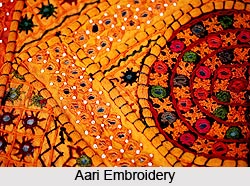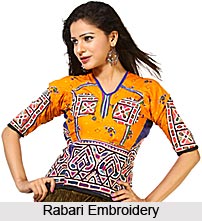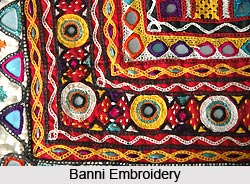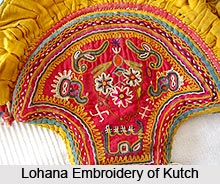 The name of Kutch has become famous for its variety of embroideries. Women produce utility articles in their leisure time. The indigenous crafts flourished under patronage of the princely states. They captured Indian as well as foreign markets. The deep rooted custom of giving embroidered articles as dowries to brides also supported the craft.
The techniques of producing variety of rich embroideries in ethnic style are handed down from mother to daughter from generation to generation. Embroidery from the Banni region has earned name among the art connoisseurs all over the world. In the absence of natural fauna and flora, Banni women have created a seconded nature with a variety of colours. Each community has its own distinctive style of needle work.
The name of Kutch has become famous for its variety of embroideries. Women produce utility articles in their leisure time. The indigenous crafts flourished under patronage of the princely states. They captured Indian as well as foreign markets. The deep rooted custom of giving embroidered articles as dowries to brides also supported the craft.
The techniques of producing variety of rich embroideries in ethnic style are handed down from mother to daughter from generation to generation. Embroidery from the Banni region has earned name among the art connoisseurs all over the world. In the absence of natural fauna and flora, Banni women have created a seconded nature with a variety of colours. Each community has its own distinctive style of needle work.
Embroidery also communicates self and status. Differences in style create and maintain distinctions that identify community, sub-community, and social status within community. The so-called "mirror work" of Kutch is really a myriad of styles, which present a richly textured map of regions and ethnic groups. Each style, a distinct combination of stitches, patterns and colors, and rules for using them, was shaped by historical, socio-economic and cultural factors. Traditional but never static, styles evolved over time, responding to prevailing trends.
Aari Embroidery
Embroidery is worked with the help of an "AAR" holed needle, where the thread is introduced from below. This is also known as "Mochi Bharat" (Cobbler`s stitch). In the earlier days silk thread was used on satin (Gaji) although the technique is simple in principle it requires considerable skill and long practice. This art grew and flourished under the patronage of royal families in Kutch and Saurashtra. "Butti" of Persian origin peacocks in beaituful forms, stylized flowering bushes and "Patli" were some of the motits commonly used.
It is possible to find its samples in Aina mahal, Kutch museum and the Bharatiya Sanskruti Darshan (The Folk museum) in Bhuj.
Ahir Embroidery
The Ahirs, who migrated from Gokul Mathura settled mostly in Kutch and Saurashtra. They are mostly engaged in agriculture. Women of the Ahir community do needle work, when they get time from the work m the house and fields. This embroidery resembles Rabari stitches but only round mirrors are used with geometrical and floral motifs. Their dresses are embellished with embroidered articles. Kotay, Dhori, Sumraser, Habai, Lodai, Dharempur, Padhar, Dhanette, Mamuara, Nagor, Cheperedi are main centres of Ahir embroidery.
Rabari Embroidery
Rabaris are mainly settled in postural Kutch. Rabari women are known for their gorgeous and very impressive embroidery that is emblematic of their nomadic life. Ornamentation in Kutch is done by using minute close chain stitches whereas in the Mehasana district cross stitches using "Abhla" are used. Their embroidery is similar to Saurashtra style. The Rabaris liberal use of mirrors of various shapes triangular, round square and almond shaped for example. The embroideries when completed are given to the groom as dowry.
Bavalia
Bavalia (Known as Kutch Bharat in Saurashtra and north Gujarat) is the simplest form of needle work common to all communities. It is also known as sada Taka. It uses cross stitch and button-hole stitch for fixing mirrors. Only geometrical designs are employed.
 Banni
Banni
This needle work derived its name from the semi-desert areas called Banni in the Kutch district. It is a long tract of 2,144 Sq. Km. where 44 villages form hamlets (Vandhs) People in this area are engaged in tertiary occupations like embroidery, leather work, dairy and other cottage industries. Banni embroidery is locally known as "Kutch Bharat"
Khambira, Kharek, Kodi, Kacho Bharat Fako Bharat etc are main stitches used m this area. The work is known for minute designs in gorgeous colours embroidered articles are closely associated with their day to day needs.
Soof
Soof embroidery is done by Sodha Rajput and Harijan women who migrated from Pakistan during the 1971. Indo-Fak war and who settled in Zura, Sumraser, Fragper and bordering villages of Banaskatha District (Bhabhar). It is also called "Sodha Bharat". Embroidery is done by using satin thread by inserting the needle from behind the cloth and designs come on the front side.
Jat Embrodiery of Kutch
Jats have migrated from Baluchistan via Pakistan and settled in Kutch. Chain and inverted chain stitches along with interlacing and button-hole stitches are common in their embroidery. Mirrors of small dimension are inset with great care. Only the front of "ABHA" or "KANJAR uses embroidered designs with refined work. Embroidery is closely related to their life.
Mutva Embrodiery of Kutch
Mutva embroidery derives its name from Mutva (Maldhari) which is a subcaste of Muslims living in Banni. Mutva embroidery is the finest in the Banni area. Mutvas are expert in workmanship of all styles of embroidery. The work is carried out using silk threads. This work is extremely intricate.
Lohana Embrodiery of Kutch
Lohana is a business community in Kutch. The housewives of this high caste community are known for their clear work. They make use of chain stitch, button hole stitch, filling cross stitch, saree, borders, blouses, handkerchiefs, torans, chaniya and wall hangings are produced at Bhuj, Anjar, Gandhidham and Khavda.
Articles of production:
Chakla, toran, Sak, toran, Ghagra, Patti, petticoat, Skirts, Sarees, Kanjari, Payjamas, topla (cap) Godali, (quilt) bags, Cushion, covers, Punjabi dress, pillow covers and yoke piece are commonly produced.
Leather embroidery
Artistic leather work is a traditional craft of the Kutch district especially of the Banni. Locally available hide is kept in a big jar, immersed under earth for a long period containing water, latex and lime. Sometimes the bark of babul trees is added to the mixture to give the leather a red tinge. Then, the hair is removed the skin is stitched at edges like a bag and is filled with a solution of babul (Chhilka of babul soaked in water for few days) for a further period of 3 to 4 days. After this the stitches are freed and the leather is used for manufacturing various articles. Designs of Fish, mor (Peacock) Flower, Butti Double Butti are common decorations. Main craft pockets are the villages of Bhirendiara, Khavda, Dinara, Kuran, Kunaria, Hodko, Dumado, Gorewali, and Dhordo.






